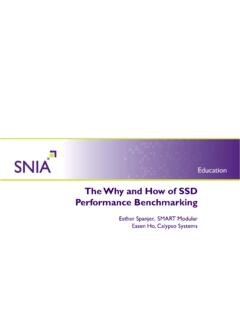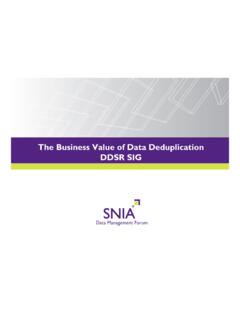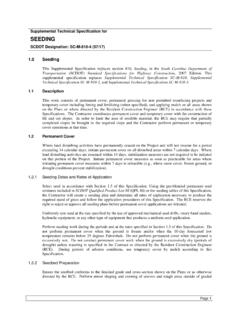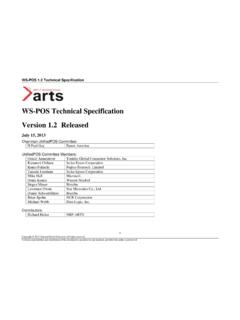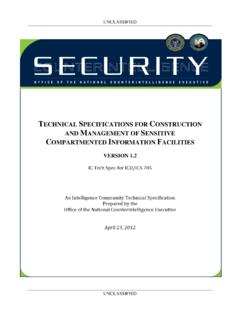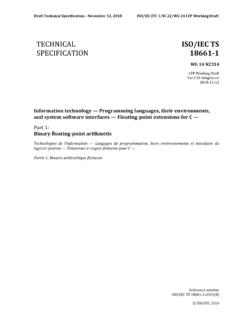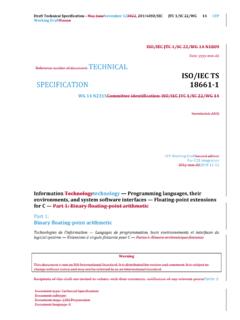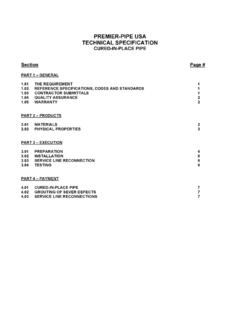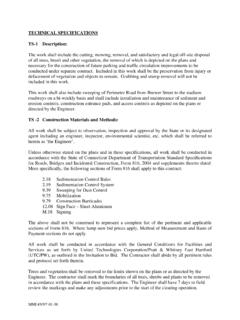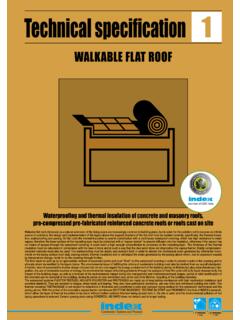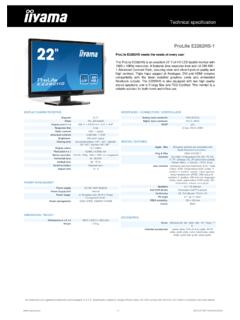Transcription of Storage Management Technical Specification, Part 1 ... - SNIA
1 Storage Management Technical specification , part 1 Common ArchitectureVersion , Rev 6 This document has been released and approved by the SNIA. The SNIA believes that the ideas, methodologiesand technologies described in this document accurately represent the SNIA goals and are appropriate forwidespread distribution. Suggestion for revision should be directed to the Technical Council Managing Director Technical Position21 April, 2009NO_ANSI_ID SMI-S Rev 6 SNIA Technical PositioniiiRevision HistoryRevison 1 Date: 4 January, 2007 SCRs Incorporated: noneComments Editorial comments 2 Date 14 April 2007 SCRs Incorporated and other changesInstallation Clause - Added text for Multi-tenant CIMOM & Multiple CIMOM Coexistence support (MP-SMIS-SCR00039) (6-1-0)Deploying SMI-S with DMTF Profiles Annex - Added this new annex (SMIS-130-Draft-SCR00010) (4-0-0)CommentsOnly minor editorial work for this 3 Date 19 June 2007 SCRs Incorporated and other changesFront Matter: Typographical Conventions - Updated the description of Experimental (SMIS-120-Errata-SCR00061) (12-1-1)Clause 9.
2 Standard Messages- Updated the list of Common Messages, (CORE-SMIS-SCR-00028) (1-0-2)- Added FC Messages in Message Registry, (FC-SMIS- SCR00034) (2-0-0)CommentsEditorial notes to INCITS editor queries re SMI-S incorporated as Conventions revised in all books: Revised explanation of Experimental text (per SMIS-120-Errata-SCR00061 - Typographical Conventions), added explanations of Draft and Editorial 4NO_ANSI_IDivDate 20 July 2007 SCRs Incorporated and other changesClause 9: Standard Messages - Updated & promoted to Experimental the list of Common Messages, (CORE-SMIS-SCR-00028)(2-1-0) - Promoted to Experimental the Fabric Message Registry (SMIS-130-Draft-SCR00016) (3-0-0)Added an annex describing the WQL and CQL filter string patterns used in SMI-S. CommentsEditorial notes displayed, but the DRAFT material is 5 Date 14 November 2007 SCRs Incorporated and other changesNoneCommentsEditorial notes and DRAFT material are not 6 Date 14 January 2009 SCRs Incorporated and other changesReferences to Storage Management Technical specification , part 7 Information Lifecycle Management , Incorrect HealthState values (SMIS-130-Errata-SCR00004)CQL mandatory for new indication filters (SMIS-130-Errata-SCR00006)Clarified logic for addressing the SLP overflow bit in Discovery Clause (SMIS-130-Errata-SCR00015)CommentsEditor ial notes and DRAFT material are not for changes or modifications to this document should be sent to the SNIA Storage ManagementInitiative Technical Steering Group (SMI-TSG)
3 At SMI-S Rev 6 SNIA Technical PositionvThe SNIA hereby grants permission for individuals to use this document for personal use only, and for corporationsand other business entities to use this document for internal use only (including internal copying, distribution, anddisplay) provided that: 1)Any text, diagram, chart, table or definition reproduced must be reproduced in its entirety with no alteration, and, 2)Any document, printed or electronic, in which material from this document (or any portion hereof) is repro-duced must acknowledge the SNIA copyright on that material, and must credit the SNIA for granting permis-sion for its reuse. Other than as explicitly provided above, you may not make any commercial use of this document, sell any or thisentire document, or distribute this document to third parties. All rights not explicitly granted are expressly reservedto to use this document for purposes other than those enumerated above may be requested by please include the identity of the requesting individual and/or company and a brief description ofthe purpose, nature, and scope of the requested 2003-2009 Storage Networking Industry SMI-S Rev 6 SNIA Technical PositionviiINTENDED AUDIENCEThis document is intended for use by individuals and companies engaged in developing, deploying, and promotinginteroperable multi-vendor SANs through the SNIA information contained in this publication is subject to change without notice.
4 The SNIA makes no warranty ofany kind with regard to this specification , including, but not limited to, the implied warranties of merchantability andfitness for a particular purpose. The SNIA shall not be liable for errors contained herein or for incidental orconsequential damages in connection with the furnishing, performance, or use of this for revisions should be directed to 2003-2009 SNIA. All rights reserved. All other trademarks or registered trademarks are the property oftheir respective of the CIM Schema are used in this document with the permission of the Distributed Management TaskForce (DMTF). The CIM classes that are documented have been developed and reviewed by both the StorageNetworking Industry Association (SNIA) and DMTF Technical Working Groups. However, the schema is still indevelopment and review in the DMTF Working Groups and Technical Committee, and subject to TO THE SPECIFICATIONEach publication of this specification is uniquely identified by a three-level identifier, comprised of a versionnumber, a release number and an update number.
5 The current identifier for this specification is version publications of this specification are subject to specific constraints on the scope of change that ispermissible from one publication to the next and the degree of interoperability and backward compatibility thatshould be assumed between products designed to different publications of this standard. The SNIA has definedthree levels of change to a specification : Major Revision: A major revision of the specification represents a substantial change to the underlying scopeor architecture of the SMI-S API. A major revision results in an increase in the version number of the versionidentifier ( , from version to version x). There is no assurance of interoperability or backwardcompatibility between releases with different version numbers.
6 Minor Revision: A minor revision of the specification represents a Technical change to existing content or anadjustment to the scope of the SMI-S API. A minor revision results in an increase in the release number of thespecification s identifier ( , from to ). Minor revisions with the same version number preserveinteroperability and backward compatibility. Update: An update to the specification is limited to minor corrections or clarifications of existing specificationcontent. An update will result in an increase in the third component of the release identifier ( , from ). Updates with the same version and minor release levels preserve interoperability and CONVENTIONSThis specification has been structured to convey both the formal requirements and assumptions of the SMI-S APIand its emerging implementation and deployment lifecycle.
7 Over time, the intent is that all content in thespecification will represent a mature and stable design, be verified by extensive implementation experience, assureconsistent support for backward compatibility, and rely solely on content material that has reached a similar level ofmaturity. Unless explicitly labeled with one of the subordinate maturity levels defined for this specification , contentis assumed to satisfy these requirements and is referred to as Finalized . Since much of the evolving specificationcontent in any given release will not have matured to that level, this specification defines three subordinate levelsof implementation maturity that identify important aspects of the content s increasing maturity and stability. Eachsubordinate maturity level is defined by its level of implementation experience, its stability and its reliance on otherNO_ANSI_IDviiiemerging standards.
8 Each subordinate maturity level is identified by a unique typographical tagging conventionthat clearly distinguishes content at one maturity model from content at another Maturity LevelNo material is included in this specification unless its initial architecture has been completed and reviewed. Somecontent included in this specification has complete and reviewed design, but lacks implementation experience andthe maturity gained through implementation experience. This content is included in order to gain wider review andto gain implementation experience. This material is referred to as Experimental . It is presented here as an aid toimplementers who are interested in likely future developments within the SMI specification . The contents of anExperimental profile may change as implementation experience is gained.
9 There is a high likelihood that thechanged content will be included in an upcoming revision of the specification . Experimental material can advanceto a higher maturity level as soon as implementations are available. Figure 1 is a sample of the typographicalconvention for Experimental content. Implemented Maturity Level Profiles for which initial implementations have been completed are classified as Implemented . This indicates thatat least two different vendors have implemented the profile, including at least one provider implementation. At thismaturity level, the underlying architecture and modeling are stable, and changes in future revisions will be limited tothe correction of deficiencies identified through additional implementation experience. Should the material becomeobsolete in the future, it must be deprecated in a minor revision of the specification prior to its removal fromsubsequent releases.
10 Figure 2 is a sample of the typographical convention for Implemented Maturity LevelOnce content at the Implemented maturity level has garnered additional implementation experience, it can betagged at the Stable maturity level. Material at this maturity level has been implemented by three different vendors,including both a provider and a client. Should material that has reached this maturity level become obsolete, it mayonly be deprecated as part of a minor revision to the specification . Material at this maturity level that has beendeprecated may only be removed from the specification as part of a major revision. A profile that has reached thismaturity level is guaranteed to preserve backward compatibility from one minor specification revision to the a result, Profiles at or above the Stable maturity level shall not rely on any content that is Experimental.



